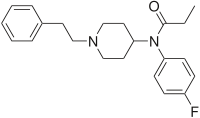Parafluorofentanyl
 | |
| Clinical data | |
|---|---|
| ATC code |
|
| Legal status | |
| Legal status |
|
| Identifiers | |
| CAS Number | |
| PubChem CID | |
| ChemSpider | |
| UNII | |
| ChEBI | |
| CompTox Dashboard (EPA) | |
| Chemical and physical data | |
| Formula | C22H27FN2O |
| Molar mass | 354.469 g·mol−1 |
| 3D model (JSmol) | |
show
InChI | |
| | |
Parafluorofentanyl (4-Fluorofentanyl) is an opioid analgesic being an analogue of fentanyl developed by Janssen Pharmaceutica in the 1960s.[1]
4-Fluorofentanyl was sold briefly on the US black market in the early 1980s,[citation needed] before the introduction of the Federal Analog Act which for the first time attempted to control entire families of drugs based on their structural similarity rather than scheduling each drug individually as they appeared.[2] 4-Fluorofentanyl is made with the same synthetic route as fentanyl, but by substituting para-fluoroaniline for aniline in the synthesis.[3]
Side effects of fentanyl analogs are similar to those of fentanyl itself, which include itching, nausea and potentially serious respiratory depression, which can be life-threatening. Fentanyl analogs have killed hundreds of people throughout Europe and the former Soviet republics since the most recent resurgence in use began in Estonia in the early 2000s, and novel derivatives continue to appear.[4]
See also[]
- 3-Methylbutyrfentanyl
- 3-Methylfentanyl
- 4-Fluorobutyrfentanyl
- 4-Fluoroisobutyrfentanyl
- α-Methylfentanyl
- Acetylfentanyl
- Butyrfentanyl
- Furanylfentanyl
- Orthofluorofentanyl
- List of fentanyl analogues
References[]
- ^ US patent 3164600
- ^ Henderson GL (March 1988). "Designer drugs: past history and future prospects". Journal of Forensic Sciences. 33 (2): 569–75. doi:10.1520/JFS11976J. PMID 3286815.
- ^ Ulens C, Van Boven M, Daenens P, Tytgat J (September 2000). "Interaction of p-fluorofentanyl on cloned human opioid receptors and exploration of the role of Trp-318 and His-319 in mu-opioid receptor selectivity" (PDF). The Journal of Pharmacology and Experimental Therapeutics. 294 (3): 1024–33. PMID 10945855.
- ^ Mounteney J, Giraudon I, Denissov G, Griffiths P (July 2015). "Fentanyls: Are we missing the signs? Highly potent and on the rise in Europe". The International Journal on Drug Policy. 26 (7): 626–31. doi:10.1016/j.drugpo.2015.04.003. PMID 25976511.
- Drugs not assigned an ATC code
- Synthetic opioids
- Piperidines
- Fluoroarenes
- Propionamides
- Anilides
- Mu-opioid agonists
- Designer drugs
- Fentanyl
- Analgesic stubs
